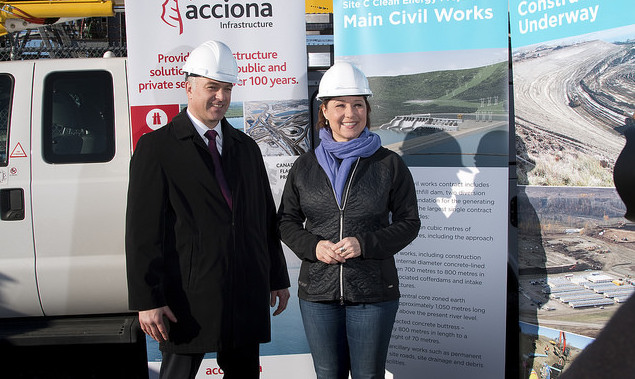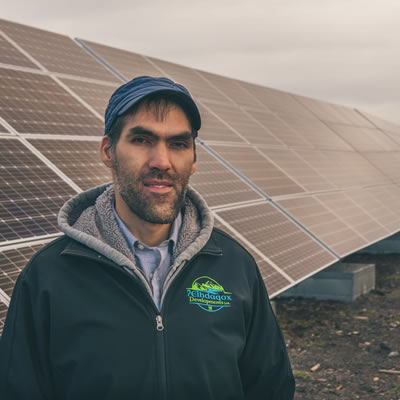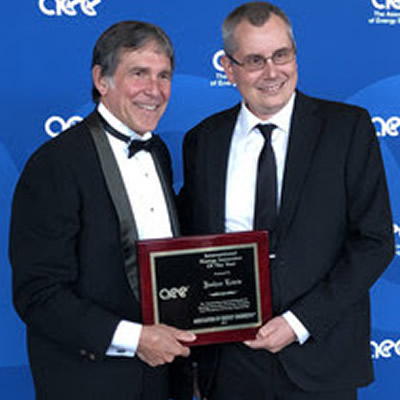Site C’s main civil works contract will create thousands of jobs

Premier Christy Clark and BC Hydro announced the preferred proponent for Site C’s main civil works contract, which will see 1,500 jobs created during peak construction. — Photo courtesy Government BC
BC Hydro has awarded the Peace River Hydro Partners (PRHP) proponent group the main civil works portion of the Site C Project—the partnership consists of CLAC signatory Petrowest Corporation, Acciona Infrastructure Canada Inc., and Samsung C&T Canada Ltd.
The civil contract is the project’s largest, including construction of an earthfill dam, two diversion tunnels and a concrete foundation for the generating station and spillways. Other contracts relating to Site C include turbines and generators, generating station and spillways, Highway 29 realignment, and substation and transmission lines.
“Peace River Hydro Partners are excited to be part of building a legacy project that will benefit British Columbians for generations to come,” said Rick Quigley of Peace River Hydro Partners.
“Our partnership has strong roots in Fort St. John, and I’m proud to be a part of the team building a clean energy project in the same community in which I live and work. We look forward to working closely with local workers and First Nations communities to maximize the economic opportunity for families in the Peace region,” he said.
The Site C construction project is expected to contribute $3.2 billion to the provincial economy.
The earthworks required at the site include approximately 32 million cubic metres of excavation for structures, including the approach channel and tailrace.
It also encompasses river diversion works, including construction of two 10.8-metre internal diameter concrete-lined tunnels between 700 metres and 800 metres in length; associated cofferdams and intake and outlet structures; and an earthfill dam.
The dam comprises central core-zoned earth embankment approximately 1,050 metres long and 60 metres above the present river level.
A roller-compacted concrete buttress will stand approximately 800 metres in length to a maximum height of 70 metres, and significant ancillary works such as a permanent network of site roads, site drainage and debris-handling facilities are also required.
Once built, Site C is slated to provide more than 100 years of clean, reliable and affordable electricity—enough to power about 450,000 homes per year.
Peace River Hydro Partners is focusing its labour efforts on providing economic opportunities to the Peace region, with particular focus on jobs training and apprenticeships.
As many as 600 people are expected to go to work on the site’s construction by May of this year, and the total will peak at 1,500 toward the middle of 2018.
Throughout the project PRHP will require machine operators, tunnellers, carpenters, construction supervisors, surveyors, engineers, electrical and mechanical professionals, labourers and administrators, and intends to hire locally whenever possible.
PRHP partners Acciona Infrastructures Canada and Petrowest have in the past hired local workers and contractors on other major capital projects including the Fort St. John Hospital project, during which Acciona worked with Northern Lights College to set up training programs in the region.
Emmanuelle Roux, marketing and business development associate for Acciona Infrastructures Canada, said the civil contract, which requires around 8,000 person hours, will draw from a predominantly B.C.-based workforce, unless there are shortages.
“We will holding B2B and job fairs with BC Hydro at the end of January and beginning of February,” said Roux. “Those fairs will be a great opportunity for residents of the Peace Region and skilled tradespeople through the B.C. province to meet our team.”
Although specific labour numbers are not yet available, Roux estimates approximately 1,500 people will be working on the main civil works at the peak of construction. Specialized training will be required and provided.
“Safety training will be provided to each worker as well as an orientation session that will be tailored according to the job position,” she said. “There will also be some opportunities for apprenticeship training programs.” The details of these programs are not yet available.
The potential market impact of the project is significant, with surrounding communities slated to benefit the most.
“It is a phenomenal economic opportunity for the Peace Region,” said Roux. “The construction of Site C is taking place at a time when the natural resource sector is in an economic slowdown. As a result, Site C construction is providing an opportunity to employ many people from surrounding communities who may have been affected by the economic downturn in mining and oil and gas.”
Dave Prentice, CLAC BC director, said, “This project will provide long-term employment opportunities for our members, residents of the Peace River region, First Nations peoples and skilled tradespeople throughout the province.”
CLAC has operated an office out of Fort St. John since 2006 when it was established to serve member companies working in the Peace River region on Cabin Gas, Saturn Sister Plant, Fort St. John Hospital and other major projects.
The CLAC Training and Jobs Teams work throughout the province establishing labour and recruitment and sourcing programs. “Our partnerships with trainers, industry and communities throughout the province, including those with First Nations, enable us to offer essential skills and safety training as well as financial and practical support to tradespeople, apprentices and those seeking to enter the trades,” said Larry Richardson, CLAC Training, BC, director, in a news release from CLAC BC.
“This is an exciting time for CLAC members and skilled tradespeople throughout BC,” said Prentice. “They'll be constructing the largest project in the history of the province.”




